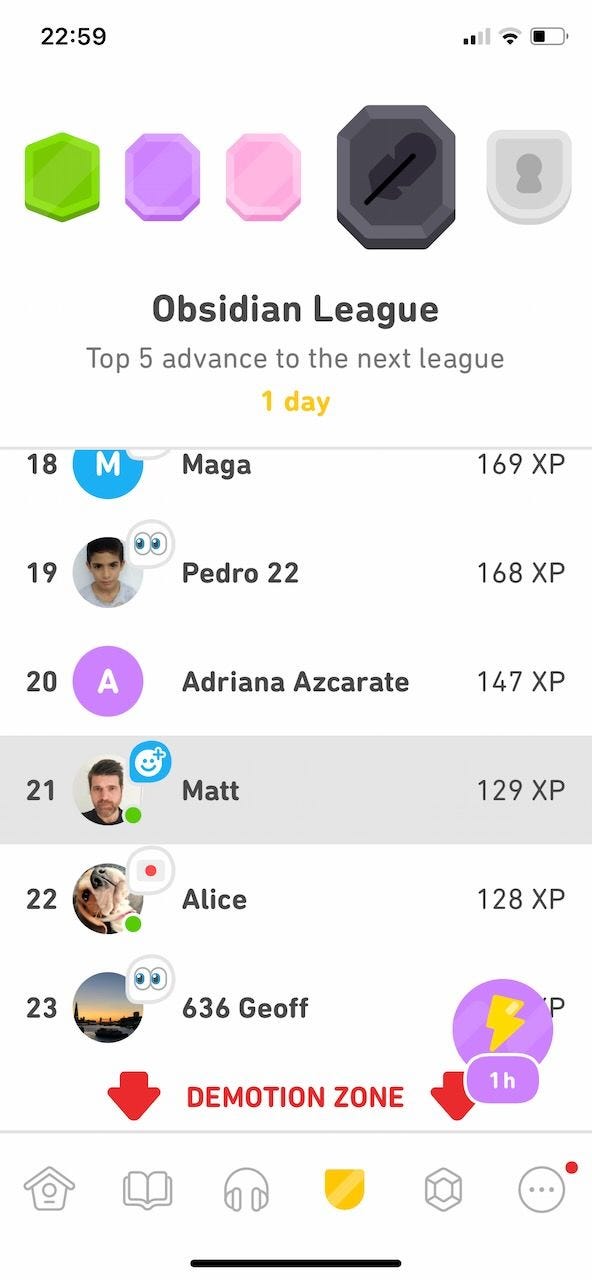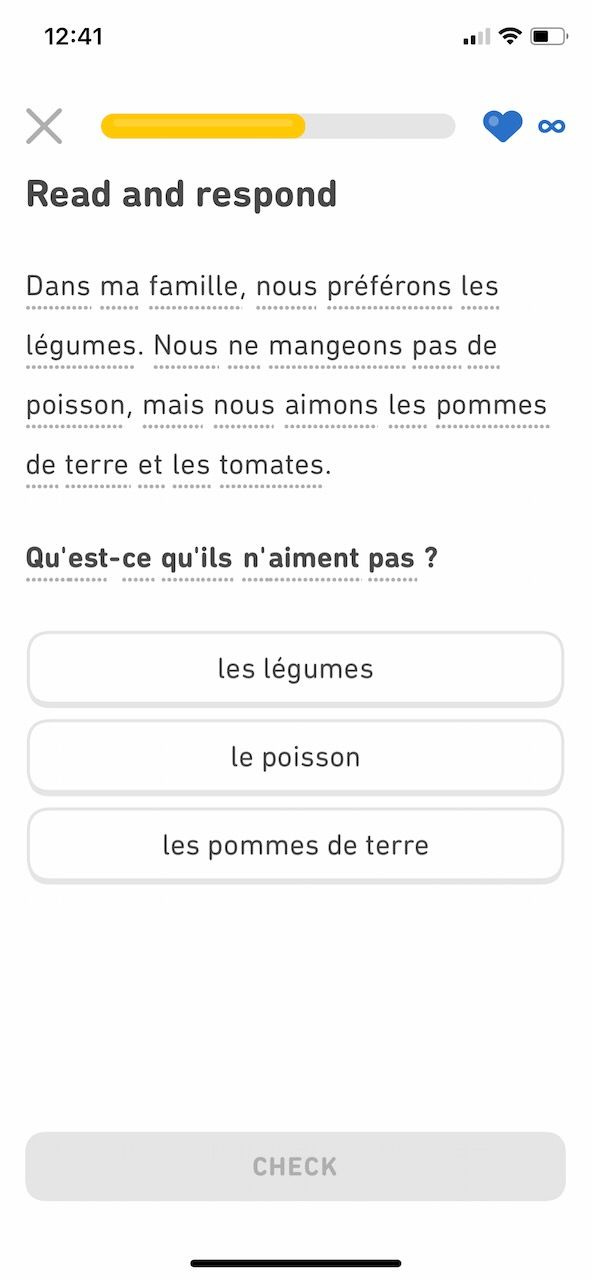What a one year streak in Duolingo taught me about community gamification

The news last winter was pretty grim. Here in the UK, a new COVID variant was wreaking havoc. Days before Christmas, we were put into another lockdown. With non-essential shops and schools closed for the second time in a year, it's fair to say the outlook was bleak.
After weeks of mood-lowering doom-scrolling in January, I decided to find something more positive to do with my time.
Enter a little green owl
Duolingo promises to help you learn a new language in just a few minutes every day. I was learning French in school an embarrassingly long time ago, so it felt like a sensible idea to pick it up again.
I committed to completing at least one of Duolingo's lessons daily for a month to resist the siren song of Twitter and its many dark THINGS.
I stuck with it for the month and formed a daily habit around one or two lessons. Over time, I watched my streak grow and today I hit my one year award.
Did it stop me from doom-scrolling?
Well, sadly not. I just made sure that I used Duolingo before indulging in hot takes.
Did I learn French? Kind of, but first, let me break down the mechanics of Duolingo's gamification as it is pretty comprehensive with many ways to hook you.
The Duolingo learning system
Duolingo breaks learning a language down into units, which have a checkpoint to recap what you learned before proceeding to the next unit.
Each unit consists of several topics (e.g. "people", "eating out", "shopping", etc.), with the goal to turn each topic 'gold' by progressing through all the steps of that topic. You cannot proceed to other subjects until you have completed at least the first level of each topic.
The topics get progressively more complex as you proceed through the units.
The Duolingo gamification system
The gamification system is geared around competing with others by earning XP represented by positions within a ladder of leaderboards.
You can also collect gems that can be redeemed for in-game rewards (new topics to learn, new outfits for your Owl, streak repair, etc.), but this is extra to the gamification engine.
You earn XP each time you complete a lesson. Each lesson varies in length but tends to be between seven and fourteen questions. You can earn bonus XP for hard lessons, completing a topic and getting many correct answers in a row.
This XP translates into a position on the leaderboard. Each leaderboard has 30 random players. There are demotion and promotion zones in each leaderboard which are actioned every Sunday night.
The leaderboard structure means that you can drop down to lower-level leaderboards if you do not earn enough XP. Likewise, you are rewarded for earning a lot of XP by being promoted to the next leaderboard until you reach the platinum leaderboard, where you jostle to remain in this leaderboard with the other players.
A year with Duo
During moments of reflection and a yearning for personal growth, I've often committed to various goals, such as daily journaling, meditation, weight lifting and losing 10kg. Each goal slowly withers into a dehydrated husk before crumbling into dust at some point through the year.
With Duolingo, I got to one year without missing a single day because the simple structure, gamification elements and nudges worked.
"The task of building a good habit is like cultivating a delicate flower one day at a time." - James Clear
Parlez-vous français?
My first few lessons with la chouette verte were fun, easy and I felt in control. After a few days, I felt like I had started to absorb a little French. Simple structures and phrases began to stick, and this spurred me on.
I quickly moved up the leaderboards, and within a few months, I was in the top-tier "platinum" leaderboard. I spent between 5 and 10 minutes a day, with perhaps 20 minutes on a Sunday, to ensure I either kept my place on the leaderboard or got promoted to the next level.
The gamification elements helped me form a learning habit, although I had a few nights when I was about to go to sleep before remembering I had not completed a lesson.
I gradually worked my way through the units and the lessons as they became more complex, challenging and time-consuming.
And that is when I started cheating the system.
Gaming the system
Humans are lazy. We are hardwired to find the path of least resistance to conserve energy for survival. I'm sure our primitive ancestors had more demanding tasks than tapping on a phone, but the process of finding shortcuts appears to be part of our DNA.
After months with Duolingo, I found a quick and effortless way to gain enough XP points to maintain my position.
Perhaps I should have titled this blog "One weird trick to beating Duolingo."
On average, I needed around 180 XP points a week to maintain my leaderboard position. A single lesson is worth 10 XP. To complete a topic, the final lesson is a little more complicated but worth 20 XP.
Once you have completed all the levels of a topic, it turns gold. Then you have a chance to become "legendary" at the topic, turning it purple. Over time, these gold and purple topics 'break' and can be repaired to refresh your knowledge of that one topic.
Each lesson towards legendary is worth 20 XP; likewise, repairing a broken gold topic with a "hard" lesson is worth 20 XP.
You can simply repair the first unit's easy topics (Basics, People, Activities) repeatedly. These lessons tend to be short and straightforward, taking little brainpower or time to gain 20 XP.
Seven days with a simple lesson per day is worth 140 XP. So, to meet my minimum survival quota, I race through a few more simple lessons every Sunday.
I stopped learning French and started collecting XP to obtain the rewards and maintain my position.
What's Next
Last January, in the depths of the pandemic, I wanted to use the time positively. Learning a language was a noble goal, and felt like it would help distract from events outside my window.
When I started, I had a goal of getting to one year. Now that I have achieved that, I will focus on the learning and less on XP. If that means earning just 10 XP a day on a complex lesson that moves my learning forward, and I drop down the leaderboard structure, then so be it.
Progress over point collection.
I have become a confident learner with French but far from fluent in anything other than greetings, asking people if they are a cat, discussing the education and location of family members, ordering in restaurants and perhaps asking a store owner if they have this t-shirt in red.
This is not the fault of Duolingo, it is very good at what it does, and you can only take out what you put in.
To become fluent, you need immersion and speak with native speakers.
What did I learn from a year with Duolingo?
Lesson 1: Gamification helps onboarding
A habit is just unconscious repetition. For example, one of the first things I do is reach for my toothbrush every morning. It's not something I need to think about; it's largely automatic. Anyone with children knows that it takes a while for this repetition to stick.
Gamification is a great way to get new members back to your community by leveraging extrinsic motivators and classic FOMO. Badges or awards for regularly visiting along with short streak awards such as 'logged in daily for a week' help build new habits with your members.
You can also reward curiosity and exploration within the community with awards to reward contributing in new areas.
Adding custom and personal awards for excellent content will also help new members feel valued within the community.
Lesson 2: Gamification is fun, but its power wanes
Duolingo taught me that the game elements were fun but not endlessly so.
I was in the platinum league for a long time until I was knocked into the demotion zone a few minutes before the leaderboards reset on a Sunday and dropped down a leaderboard level. After that experience, I stopped trying so hard to get promoted.
It's natural that eventually, your members will tire of striving to level up or collect awards. So consider how you structure your levels to ensure they are obtainable within the first three to six months, with some stretch goals to reward those who have a little more dedication.
Lesson 3: Be careful with design
Gamification should complement good content and personal connections within the community. When gamification fails, it is because too much focus is placed on the in-game elements. Avoid the temptation to convert thoughtful content into mindless reactions and follows just to rack up enough points to reach the next level.
Consider milestone-based rewards for 5, 50 and 100 posts. Reward the behaviour you'd like to see. Rewarding great content is more potent than rewarding clicking "like" on 100 posts.
Lesson 4: Beware ghostly engagement
Once I hard-learned the rules of Duolingo, I found it easy to keep generating enough XP points to retain my high-level position within the leaderboard, but my learning journey stalled.
If Duolingo rewarded taking more complex lessons with more XP, this would not have been the case. Instead, Duolingo actively rewards refreshing already well-understood topics over new learning. This is a fundamental flaw that you do not want to repeat in your community.
Ensure your gamification design avoids the pitiful of pushing for more engagement. Most communities suffer from a lack of quality content more than pure engagement, such as clicking reactions and following other members. Unfortunately, this type of engagement doesn't contribute to the life of your community.
Lessons learned
Community gamification is often viewed with scorn and for a good reason, however smart design enhances onboarding, helps build habits that benefit the community and helps nudge members to continue contributing when intrinsic motivators initially wane.
A year spent with a green owl was a fascinating experiment to see if I could finally achieve my goal of learning another language and how turning that learning into a game helped or hindered.
To have not missed a day of Duolingo for a year is a significant achievement for someone who struggles for more than a month with something new. There is no doubt in my mind that learning for XP, which leads to status combined with the desire to keep my streak alive, has helped me achieve that goal.
The gamification elements helped me explore the app to find a new habit that worked for me.
The inherent laziness of humans to seek comfort through shortcuts should not be underestimated when designing a good framework. Therefore, continual monitoring of your systems to gauge effectiveness is critical. Gamification is not a 'set and forget tool.
Thanks for reading, and as always, come and say hello on Twitter and let me know your thoughts.
Bonne journée!
Further learning
If you are interested in learning more about the benefits and pitfalls of gamification, then have a look at these resources:
Ib4tl podcast episode "A whole bag of crap".
The Community Roundtable has a downloadable case study on how EA built their gamification systems.
More on intrinsic and extrinsic motivation: https://www.verywellmind.com/differences-between-extrinsic-and-intrinsic-motivation-2795384
Plug alert: Check out Jordan's video on Invision Community's achievements system.









